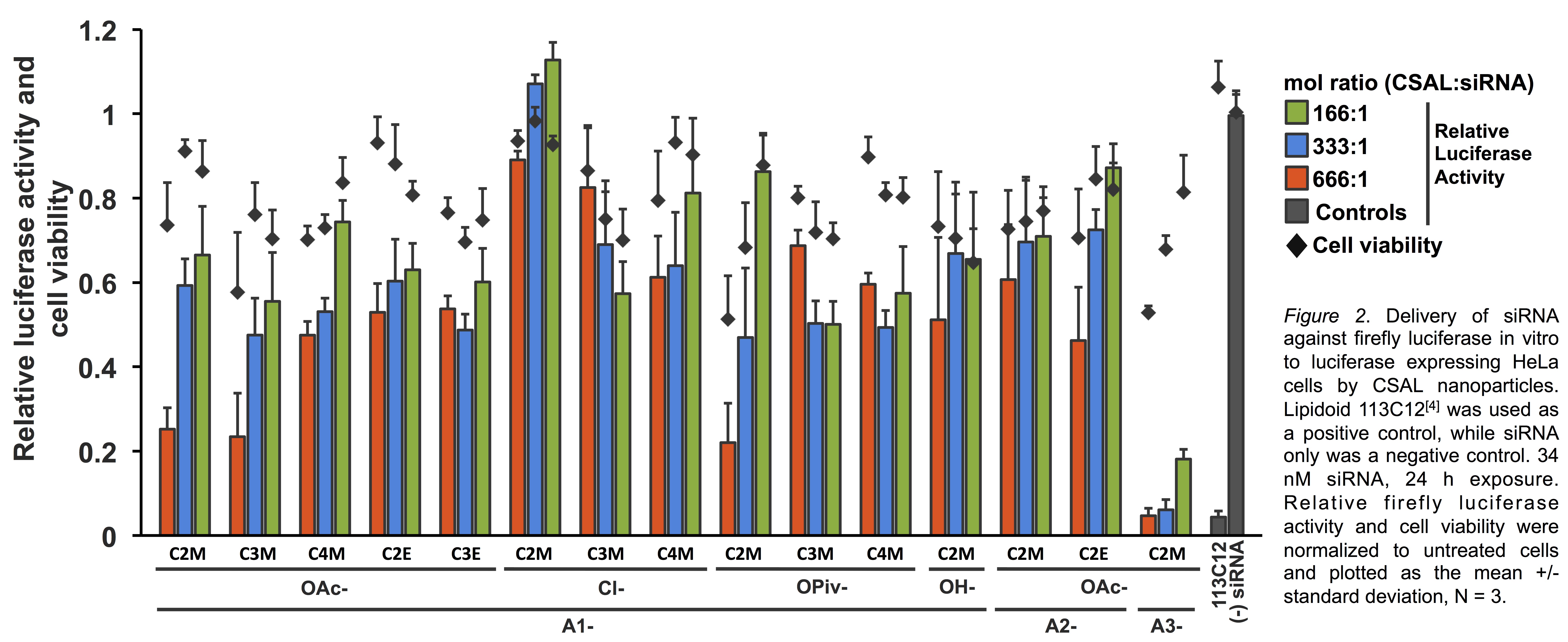Introduction: The use of RNA interference (RNAi) as a therapeutic is an exciting and rapidly developing field that offers a promising alternative to small molecule drugs for the treatment of dysregulatory diseases, including cancer [1],[2]. Small interfering RNA (siRNA) can be designed against any mRNA target, and upon loading into the RNA-induced silencing complex (RISC) can enable the sequence-specific recognition and degradation of the target oncogene. Because siRNA has a high molecular weight (~13 kDa) and is highly hydrophilic and anionic, it is unable to passively diffuse across cell membranes and into the cell [3]. To date, many successful carriers have been designed using amphiphilic lipid-like compounds containing amine-rich cores [4][5], but the challenge of efficient endosomal release remains a major bottleneck in the field of RNAi therapeutics.
Cationic sulfonamide amino lipids (CSALs) are a novel class of modular synthetic lipids that possess chemical and structural properties that make them promising candidates for RNAi-based anticancer therapies. Sulfonamide functionalities, though prevalent in many pharmaceutical drugs, have not been explored in lipid carriers for siRNA delivery. Due to a positively-charged quaternary ammonium, CSALs are excellent candidates for enhanced siRNA binding and endosomal membrane interaction and disruption upon cell uptake, which can enable siRNA release.
Materials and Methods: CSALs were readily chemically synthesized from commercially available reagents via a zwitterionic aminolipid intermediate bearing a sulfobetaine headgroup. The sidearm functionality was introduced by reaction at the alcohol positions, while the characteristic sulfonamide was introduced by further sequential reaction with thionyl chloride and a primary amine bearing the amino headgroup. A systematic, modular design enabled the evaluation of the effect of structural modifications on the biophysical properties of CSAL nanoparticles in terms of size, surface charge, siRNA encapsulation, and in vitro siRNA delivery efficacy to human cervical cancer cells.
Results and Discussion: Systematic SAR of CSALs was established by modifying the linker length between the sulfonamide and the amine headgroup, sterics at tertiary amine headgroup and quaternary ammonium, the number of hydrophobic tails, and a sidearm alcohol functionality on the periphery of the amine core in terms of both sterics and electronics (Figure 1).

CSALs showed the ability to form stable nanoparticles (Dh ~100 nm) in the presence of helper lipids DSPC, cholesterol, and PEG-lipid. Lead materials, showed excellent uptake into cells as evaluated by confocal microscopy, efficient siRNA encapsulation (97%) and in vitro target gene silencing in human cervical cancer cells with up to 90% knockdown and minimal material-derived cytotoxicity (Figure 2).

Conclusion: Systematic rational design of a library of CSALs, a novel class of synthetic lipids, has elucidated SAR in properties governing effective siRNA delivery. This led to the discovery of lead CSAL materials that enable efficacious siRNA delivery to cancer cells.
Cancer Prevention Research Institute of Texas (CPRIT) Training Grant RP140110; UT Southwestern Summer Undergraduate Research Fellowship Program
References:
[1] Pecot, C. V., et al. Nat Rev Cancer 2011, 11, 59.
[2] Whitehead, K. A.; Langer, R.; Anderson, D. G. Nat Rev Drug Discov 2009, 8, 129.
[3] Nguyen, J.; Szoka, F. C. Accounts of Chemical Research 2012, 45, 1153.
[4] Akinc, A., et al. Nat Biotech 2008, 26, 561.
[5] Love, K., et al. Proceedings of the National Academy of Sciences 2010, 107, 1864.